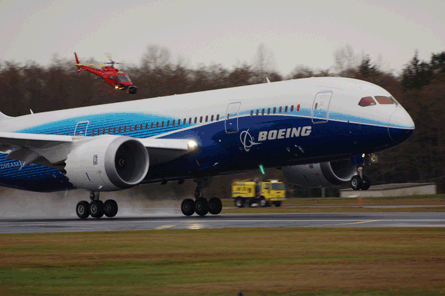Nearly three months into its planned 8.5 month-long flight test programme, the Boeing 787 is progressing well, says the head of the company’s commercial aircraft unit, but acknowledges that some schedule margin has already been used ramping up the flight test fleet.
Jim Albaugh, president and CEO of Boeing Commercial Airplanes, calls the aircraft "solid as a rock" as he recounted the milestones accomplished by the three flying 787 flight test aircraft.
Albaugh’s remarks came at the J.P. Morgan Aviation, Transportation & Defense Conference in New York City on 9 March.
Albaugh says the 787 is about 40% through flutter testing, which began on 14 February, and adds that about 100 stall tests have been completed, along with several engine-out tests and autolands.
 |
|---|
| © Jon Ostrower |
Additionally, ZA001, Boeing’s first 787 flight test aircraft, reached M.97 in a dive during a flutter test, and reached an altitude of 43,000ft while maintaining a cabin pressurisation of 6,000ft (1,830m), a key feature of the 787’s touted improved passenger experience.
"The airplane performance is very, very clean so far," says Albaugh.
To date, the three aircraft have accumulated about 260h of flight testing. The fourth, ZA003, is expected to join the flight test programme on 21 March, he adds.
Type Inspection Authorisation (TIA), which will formally kick off the FAA’s inclusion in the 787 flight test certification campaign, is expected to occur by the end of March, says Albaugh.
Albaugh’s acknowledges that "we did burn a little bit" of the built-in flight test "contingency" margin, which programme sources say had TIA initially scheduled for late-February.
During pre-first flight test briefings with the media held in April 2009, Boeing said it planned for TIA to take place about two months after first flight, which occurred on 15 December 2009.
Albaugh did not specify how much of that contingency planning margin had been used already, and says "We’re working very hard to improve the efficiency of the test programme, which means do more test points per flight. And we’re also trying to improve the turnaround of the airplane, so we can get more hours in the air with the six airplanes that we’re going to have."
Albaugh says the slower than planned start to the flight test programme was attributable to a steep learning curve and a longer aircraft turnaround time, limiting the number of daily flight test hours.
While Boeing initially planned for an 8.5-month flight test programme to certify the 787, the company expanded its planning, giving itself from fourth quarter 2009 to fourth quarter 2010 to conduct the six-aircraft 3,100h flight test campaign.
Albaugh says the schedule has "a month or month and a half of contingency in the flight test programme against the entry and the service date later this fall or early next winter. We have contingency, and I think it’s adequate. We’ve got a lot of levers that we can pull [improving] efficiency, getting airplanes in the air."
In an effort to rapidly accelerate the pace of certification, Boeing significantly changed its methodology for the 787 flight test programme, assigning teams to look holistically at the test fleet rather than individual test aircraft, as well as utilising downtime at night between flights for maintenance and preparation for the following test day to leverage all 24h in the day.
As the fourth, fifth and six flight test aircraft come online, Albaugh says the added length of the Pacific Northwestern days, providing 16h of daylight in June, will help the rapid accumulation of flight test hours.
"We’ll be flying the wings off those airplanes," says Albaugh.
Source: Air Transport Intelligence news



















